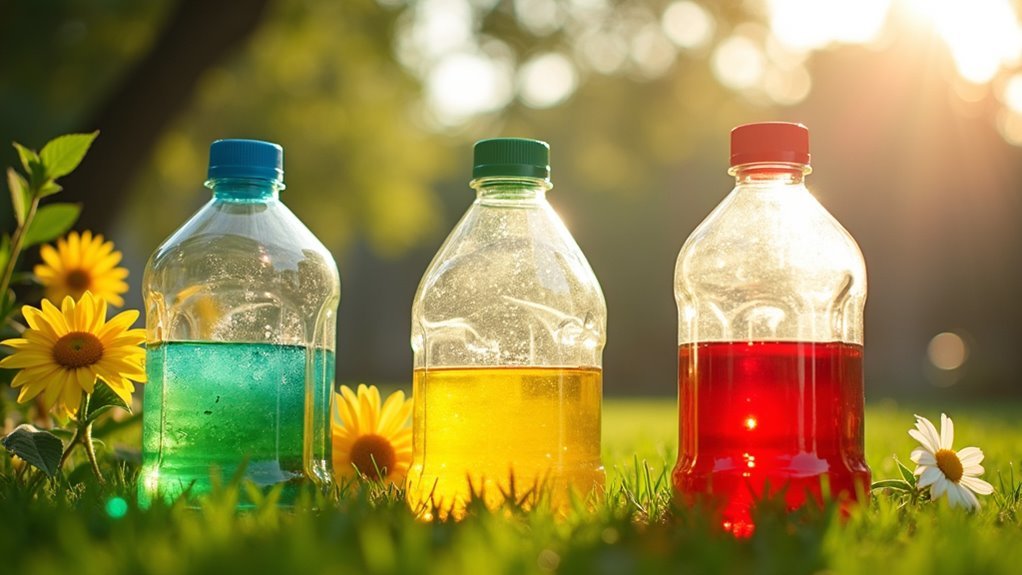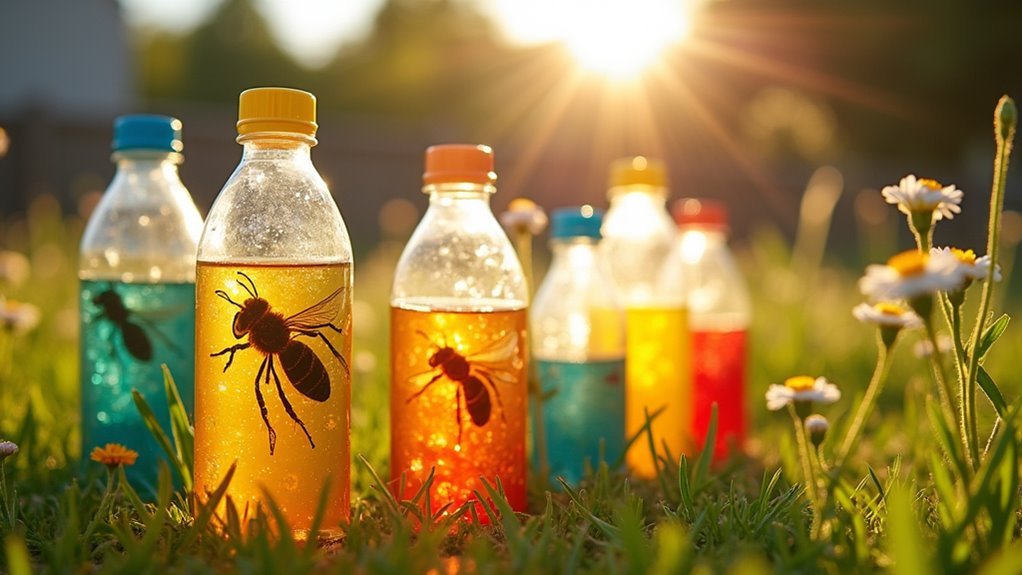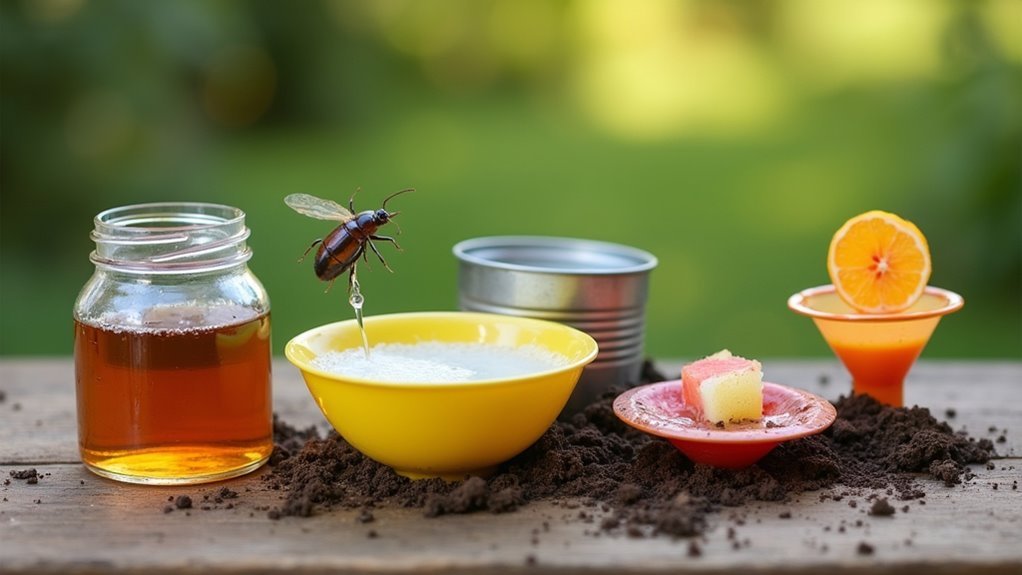DIY wasp traps are kid-friendly because they use completely non-toxic household ingredients like vinegar, sugar, and water instead of harmful commercial pesticides. Your children can safely help gather these common kitchen items and practice measuring skills while learning about pest control. The construction process offers hands-on science education and develops fine motor skills through cutting and assembling. With proper adult supervision for sharp tools and strategic trap placement, you’ll create effective pest control while keeping your family safe and discovering valuable lessons about sustainable solutions.
Non-Toxic Materials Make DIY Wasp Traps Safe for Children

When you’re dealing with wasps around your home, you’ll find that DIY traps offer a safer alternative to commercial pesticides, especially if you have children.
These kid-friendly solutions rely entirely on non-toxic materials you already have at home. You’ll use simple plastic bottles, white vinegar, sugar, salt, and water to create effective wasp control without introducing harmful chemicals into your environment.
Unlike store-bought insecticides that contain dangerous pesticides, DIY wasp traps pose no chemical threats to your family’s health.
The bait mixture consists of common kitchen ingredients that won’t harm children if accidentally touched or ingested in small amounts.
You’re creating a pest control method that targets wasps effectively while maintaining a safe space for your kids to play and explore outdoors.
Simple Ingredients Kids Can Help Gather and Measure
Getting your kids involved in making DIY wasp traps becomes effortless when you realize how simple the required ingredients are. You’ll only need white vinegar, sugar, and salt – items already sitting in your kitchen pantry.
Children can easily gather these simple ingredients from cupboards and help measure each component using standard measuring cups.
Kids love being kitchen helpers when gathering pantry staples and practicing their measuring skills with everyday cups.
This activity transforms into an educational experience where kids practice basic math skills while following recipe-style instructions. They’ll learn precise measurements as they pour sugar and measure vinegar portions.
The eco-friendly nature of these common household items teaches children about sustainable pest control methods that don’t rely on harmful chemicals. Your kids will feel accomplished contributing to this practical solution while developing measuring skills and environmental awareness.
Educational Benefits of Building Traps With Your Children

Beyond the practical measuring skills your children develop, building DIY wasp traps creates a rich learning environment that spans multiple subjects. When you make these traps together, you’re providing hands-on science experiences that foster curiosity about insect behavior and ecosystems.
Your kids learn about wasps’ important role in nature while developing fine motor skills through cutting and assembling components. The educational benefits extend to basic chemistry as children mix bait ingredients like sugar and vinegar, discovering how substances interact.
This collaborative process encourages teamwork and communication as you discuss placement strategies together. Most importantly, monitoring the traps over time teaches patience and develops observational skills.
Your children will learn about wasp life cycles while practicing critical thinking and problem-solving abilities throughout this engaging educational activity.
Adult Supervision Guidelines for Safe Trap Construction
While DIY wasp trap construction offers valuable learning opportunities, you’ll need to prioritize safety through careful adult supervision throughout every step of the building process.
Your guidance guarantees children handle sharp tools like knives and scissors properly. You should also help kids measure and mark bottles accurately to prevent cutting accidents.
Here’s what you must oversee:
- Tool safety – Direct proper knife and scissor handling techniques
- Protective clothing – Make sure children wear long sleeves and gloves during construction
- Ingredient education – Explain bait components and safe handling procedures
- Trap placement – Guide selection of safe hanging locations away from high-traffic areas
Through consistent adult supervision, you’ll create a secure environment where children learn valuable skills while staying protected from potential hazards throughout the entire trap-building experience.
How Homemade Traps Teach Kids About Nature and Pest Control

When children construct homemade wasp traps, they’re diving into a hands-on science lesson that reveals the fascinating world of insect behavior and ecosystem balance. DIY wasp traps transform pest control into an educational adventure where kids discover how insects navigate, what attracts them, and why certain species become problematic.
| Learning Aspect | Key Takeaway |
|---|---|
| Insect Behavior | Understanding wasp attraction patterns |
| Ecosystem Balance | Recognizing beneficial vs. harmful species |
| Scientific Method | Observing, hypothesizing, and testing |
| Environmental Stewardship | Balancing control with conservation |
Through monitoring their traps, you’ll watch children develop observation skills while grasping complex concepts about nature’s interconnectedness. They’ll learn that effective pest control requires understanding insect life cycles, seasonal patterns, and environmental factors. This practical experience builds respect for wildlife while teaching responsible management techniques.
Safety Precautions When Kids Are Around Active Wasp Traps
Teaching children about wasp behavior through DIY traps creates valuable learning opportunities, but active traps require serious safety measures to protect young family members.
You’ll need to implement these essential safety precautions when kids are present:
- Strategic placement – Position traps in areas children can’t easily reach, preventing accidental encounters with both wasps and trap mechanisms.
- Non-toxic baits only – Use sugar water and vinegar mixtures instead of harmful chemicals, guaranteeing spills won’t endanger curious kids.
- Regular maintenance – Remove dead wasps promptly to minimize children’s temptation to investigate the contents.
- Clear boundaries – Explain trap purposes and establish no-touch rules so kids understand potential dangers.
You should always supervise children when they’re outdoors near active traps. This constant oversight guarantees their safety while maintaining the educational value of your pest control project.
Frequently Asked Questions
Do Homemade Wasp Traps Work?
Yes, you’ll find homemade wasp traps work effectively by using sweet baits to lure wasps into containers they can’t escape. They won’t eliminate entire populations, but they’ll greatly reduce wasp numbers around your property.
What Are Some Facts About Wasps for Kids?
Wasps aren’t just scary insects – they’re actually helpful! You’ll find they eat garden pests and pollinate plants. They build paper nests from chewed wood and can sting multiple times without dying.
Why Shouldn’t You Kill Wasps?
You shouldn’t kill wasps because they’re important pollinators and pest controllers. They eat harmful insects like caterpillars that damage plants. Killing them disrupts nature’s balance and can make other pest problems worse.
What Liquid to Put in a Wasp Trap?
You’ll want to mix 3/4 cup white vinegar, 2 tablespoons sugar, and 1 teaspoon salt. Add a few drops of dish soap to prevent wasps from escaping once they’re trapped.
In Summary
You’ve discovered that DIY wasp traps offer a perfect blend of safety and learning for your family. By using non-toxic materials and simple ingredients, you’re creating effective pest control while keeping your children safe. You’re not just solving a wasp problem—you’re teaching valuable lessons about nature, problem-solving, and teamwork. Remember to maintain proper supervision and follow safety guidelines, and you’ll turn pest control into an enriching family activity.





Leave a Reply